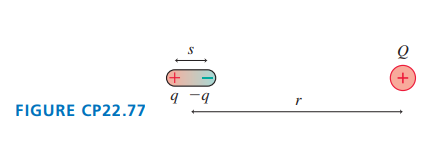In Section we claimed that a charged object exerts a net attractive force on an electric dipole. Let’s investigate this. FIGURE CP22.77 shows a permanent electric dipole consisting of charges +q and -q separated by the fixed distance s. Charge +Q is the distance r from the center of the dipole. We’ll assume, as is usually the case in practice, that s V r.
a. Write an expression for the net force exerted on the dipole by charge +Q.
b. Is this force toward +Q or away from +Q? Explain.
c. Use the binomial approximation nx if x V 1 to show that your expression from part a can be written Fnet = 2KqQs/r3 .
d. How can an electric force have an inverse-cube dependence? Doesn’t Coulomb’s law say that the electric force depends on the inverse square of the distance? Explain.




